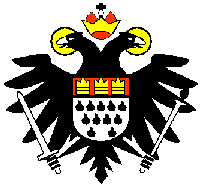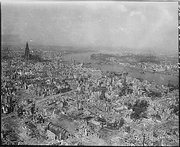Cologne
|
|
- For other uses, see Cologne (disambiguation).Missing image
CologneSkylineAtNight.jpgCologne skyline at night. The famous Cologne Cathedral is on the right. The Rhine River is in the foreground and the towers of the Town Hall (on the left) and church of Great St. Martin (center) are also seen.
Cologne_in_Germany.png
Cologne (German: Köln [kœln] Template:Audio) is, in terms of population, the fourth largest city in Germany and largest city of the state of North Rhine-Westphalia. It is one of the most important German inland ports, and considered the economic, cultural, and historic capital of the Rhineland. It is the 16th largest city in the European Union. At the end of 2003, Cologne's population was 965,954, using the standard method of counting only persons whose primary residence (German: Hauptwohnsitz) was the city. The city of Cologne includes those with non-primary residences (German: Nebenwohnsitz) in its official figure, raising it to 1,020,603.
Its location at the intersection of the Rhine (German Rhein) river with one of the major trade routes between eastern and western Europe was the foundation of Cologne's commercial importance. In the Middle Ages it also became an ecclesiastical center of significance and an important center of art and learning. Cologne was badly damaged during World War II.
Cologne has one university, which has around 49,000 students (autumn semester 2004/2005) and is renowned for its economics faculty. In addition to the university, it has 3 colleges. Fachhochschule Köln (The University of Applied Sciences of Cologne) is, with 18,000 students, the biggest college in Germany. A total of 65,000 students study in Cologne.
Cologne also has a Roman Catholic archbishopric. Cologne cathedral (German Kölner Dom), a Gothic church, was designated a World Heritage site in 1996; it is the city's major landmark and unofficial symbol. The city is 43% Roman Catholic, 18% Protestant and 39% other religions. Until World War II and the following stream of refugees arriving from eastern Germany, Roman Catholicism had a wide majority in Cologne.
Cologne has 31 museums. Exhibits range from archeological findings to contemporary painting. Alongside the established places of art exists a thriving arts scene, represented yearly at "Art Cologne", Germany's biggest arts fair.
The city occupies an important position in Germany's television industry. Traditionally it has been home to Westdeutscher Rundfunk (WDR) - the biggest branch of Germany's first public broadcaster ARD - and after the opening for privatization of the media in the 1980's established itself as base for several commercial TV channels - RTL being the biggest and commercially most successful in Germany. Cologne today is home to a wide range of television and film production companies, even though Berlin has attracted parts of the media industry after reunification.
Berlin also rivals Cologne regarding the cities' respective gay scenes. Cologne has long been known for its tolerance. The city had for long been a stronghold in Germany's queer movement. Even though Berlin has drawn some of the attention, Cologne still boasts Germany's biggest Gay Pride event (known here as Christopher Street Day) each year in July (attracting over 1 million visitors annually) and is home to a variety of LGBT organizations and businesses.
20% of Cologne's population is non-German. 40% of these are Turkish.
Cologne is well known for its beer, called "Kölsch". Kölsch is also the dialect of Cologne. It is jocularly said that Kölsch is the only language you can drink.
This year, Cologne will be witness to one of the largest meetings of the Catholic youth. The XX World Youth Day will take place from Monday, August 15, until Sunday, August 21.
| Contents |
Geography
The city covers about 405.15 km² (about 156 miles²), is located at Template:Coor dms, and is between 37.5 and 118.04 m above sea level. Its car registration prefix is K.
The Coat of Arms of Cologne
The three crowns symbolise the Magi or Three Kings whose bones are said to be kept in a golden sarcophagus in the Cathedral (see Shrine of the Three Kings at Cologne Cathedral). The eleven flames are a reminder of the Britannic princess St. Ursula and her legendary 11,000 virgin companions who were supposedly martyred at Cologne for their Christian faith by Attila the Hun in 383 A.D. In reality it was probably just 11 companions.
History
Main article: History of Cologne
Cologne became a city in 50 A.D, had a bishop as early as 313, and, in 785, became the seat of an archbishop. The Archbishop of Cologne was one of the seven Electors of the Holy Roman Empire. He ruled a large area as a secular lord in the Middle Ages, but in 1288 he was defeated by the Cologne citizens and forced to move to Bonn. Cologne was a member of the Hanseatic League, but became a free city officially only by 1475.
Cologne lost its free status, and regained its archbishopric during the French period, and, in 1815, at the Congress of Vienna was made part of the kingdom of Prussia. Cologne became an industrial city, and the cathedral, started in 1248 but abandoned in the mid-1500s, was eventually finished in 1880.
During the nineteenth and twentieth centuries, Cologne incorporated numerous surrounding towns, and by the time of World War I had already grown to 600,000 inhabitants. In World War II, it was repeatedly bombed, and much of the city was in ruins. It took some time to rebuild the city, but afterwards it grew again, and, in 1975, reached 1 million inhabitants for about one year.
City Partnerships
|
|
By merging in other cities and communes, Köln took over their partnerships, with the following: Benfleet/Castle Point (England), Igny (France), Diepenbeek (Belgium), Brive la Gaillarde (France), Dunstable (England), Eygelshoven (Netherlands) and Hazebrouck (France).
Buildings and places of interest in Cologne
Kölnturm.JPG
- In 310 Constantine builds a bridge over the Rhine at Cologne.
- Cologne cathedral (der Kölner Dom) is the city's famous landmark.
- University of Cologne
- Fragrance-Museum Farina House, the birthplace of Eau de Cologne
- Wallraf-Richartz Museum
- Museum Ludwig
- Römisch-Germanisches Museum
- Ford Motor Company plants, assembling the Ford Fiesta and Ford Fusion as well as manufacturing engines and parts.
- RheinEnergieStadion, the major Cologne soccer stadium, seating 50,997 visitors in national games and 46,134 in international games, home to the local Bundesliga team, 1.FC Köln, and to the local NFL_Europe team, the Cologne Centurions
- Kölnarena, a multifunctional stadium, home to the local ice hockey team, the Cologne Sharks
- Kölnturm, with 150 metres in height Cologne's second tallest building, second only to the cathedral
- Colonius - a telecommunication tower with an observation deck
- Colonia-Hochhaus - German's tallest building, in which people live
- Rheinseilbahn - an aerial tramway crossing the Rhine
- Fair Tower Cologne
- The Hohe Strasse (literally: "high street") is one of the main shopping areas and extends past the cathedral in an approximately southern direction. This street is particularly popular with tourists and contains many giftshops, clothing stores, fast food restaurants and electronic goods dealers / the area around Apostelnstrasse, Ehrenstrasse, and Rudolfplatz, on the other hand, is a little more on the eccentric and stylish side and far more interesting than Hohe Strasse
- the historic Ringe boulevards (such as Hohenzollernring, Kaiser-Wilhelm-Ring, Hansaring) with their medieval city gates (such as Hahnentorburg on Rudolfplatz) are also known for their nightlife
Legalities
Cologne is the only city in Germany with an explicit tax on prostitution and other sex businesses. See the article on prostitution in Germany for details.
External links
- Photo Gallery (http://de.wikipedia.org/wiki/K%C3%B6ln/Bildergalerie)
- Cologne (http://www.koeln.de), official webpage of Cologne
- Fullscreen Cologne QuickTime VR Panoramas (http://www.panoramalampe.de/fotografie/qtvr.html) - Panorama Lamp with images from Cologne
- Cologne Cathedral QuickTime VR walkthrough (http://www.panoramalampe.de/fotografie/rundgang.html) - Walk through Cologne Cathedral
- City Panoramas (http://www.panorama-cities.net/cologne/cologne.html) - Panoramic Views of Cologne's Highlights
- Cologne-In (http://www.cologne-in.de) - alternative city guide with city maps.
- Cologne travel guide (http://www.wikitravel.org/en/article/Cologne) at wikitravel.org
- XX World Youth Day 2005 (http://www.wjt2005.de/index.php)
- Map of Cologne (http://www.hot-maps.de/europe/germany/nrw/cologne/homeen.html)
Template:Germany districts north rhine-westphaliabg:Кьолн ca:Colņnia (Alemanya) da:Köln de:Köln es:Colonia (Renania del Norte-Westfalia) eo:Kolonjo fr:Cologne he:קלן it:Colonia (cittą) la:Colonia Agrippina nl:Keulen id:Cologne no:Köln pl:Kolonia (miasto) pt:Colōnia (Alemanha) ru:Кёльн simple:Cologne fi:Köln sk:Kolķn nad Rżnom sv:Köln zh:科隆



